The Peralba Rivers
 Peralba is blessed with numerous rivers and perennial springs.
Peralba is blessed with numerous rivers and perennial springs.
Situated on the first boulders of the continental shelf, Peralbais abound with water all year long. We never run out of water. This is a good omen, in fact a golden present from the skies, as till the day we did not have a real need for irrigation. (well, besides 2012-13 when the El Niño hit us heavily). For that reason,in 2017, we shall introduce an emergency ferti-irrigation scheme, not to caught off guard again.
The widest of the rivers is the Rio da Dona. We have only one mile of this river, but it is immense, particularly during the rainy season, when the water flow expands tenfold.
The most important or intimate, for us, is the Tirirí. It runs through most ofthe farm from north to south on the western limits of the propriety.The origin of its name refers to aYoruba deity, Exu, later reincarnated as a Candomblé divinity: from Esu in Nigeria to EXú in Brazil, this deity, this ‘orixá’ was transformed from the creator of the world to the divinity that brings communication, patience, order and discipline (https://en.wikipedia.org/wiki/Eshu and https://pt.wikipedia.org/wiki/Exu_(orix%C3%A1) ). To us it brings pure water. The Tiririis born a few miles from our landsand crosses no city or village. It reaches the ocean after feeding its waters to our swamps.
It is a kind of spinal cord that also sustainsour Mata AtlanticaOeste and receives the water from two other streams that start in ourfarm: theSucupira River and the Urubu River
On the north side, we have our riacho(a perennial stream of minor size)Peralba, born from two wells at the upper limits of the farm and feeding the plantations of limes and coffee.
In the PeralbaAtlanticaLeste, the riachoPeralbaOceano is born and feeds the swamps creating a mini ‘laguncularial’and ‘avicannia’ biospheres.There is the PeralbaPort, giving us access to nearly 120kmof swamps and mangroves and immense estuaries.
Each river is described in more details:
The Tirirí, its rapids and its waterfalls
The Rio da Dona
TheriachoSucupira (ouMãe Bernarda)
TheriachoJacarandáand the Urubu waterfall
The riachoPeralbaand the lagoon of the Jacaré (Alligator)
TheriachoOceano
The Tirirí, its rapids and its waterfalls
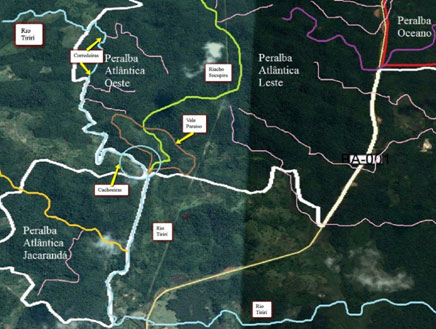
The Tirirí is borne some 6 to 8 km from the farm, out of asmall spring set in a deep valley. The main feeder is a couple of miles from our farm, and is protected by a farmer much concerned with ecological issues.

Such abundance reflects on the animal andplant lives: is not uncommon to see bucks frolicking at the river early in the morning, while monkeys and micosleõesstand by. Numerous pools festoon the meanderings of the river and they were occasional swimming places in times past, right at the beginning of the Peralba. Today, with all the commitments with the business, we seldom visit these sites, but we made sure nobody is disturbing their peace.

The water flows year round, but the Tirirí is subjected to the vagaries of the weather. In the rainy months, the flow raises to some 30m3 /sec creating immense rapids and feeding three immense waterfalls. During draughts, a flow of five to seven m3/sec is normal.

After this, things calm down. The river has reached the sea level and is now feeding the immense swamps that reach close to the ocean.
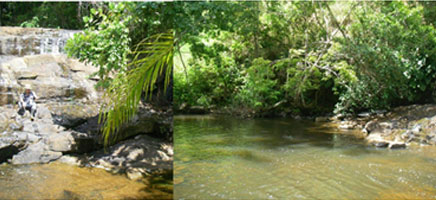
In both cases, the effect is magnificent: t in the depth of the forest, under immense canopies, the river creates an oasis of pleasure, be it with roaring waters or with calmer and more intimate flows.

However, the best parts of the river are when the water reaches three falls. Still under majestic trees, the water transforms the place in atourbillion of pure energy. With a span of 32 to 44 meters (100 to 140 feet), we had to intervene to save the young lady who dared to defy the shoots.
TheRio da Dona
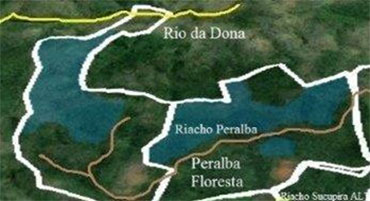
The northern upper reaches of the farmare bordered by the Ria da Dona.
This is a 150 km long river, and passes through several villages and cities. The last one Santo Antonio do Jesus, is 50 km from the farm. There the water is collected in a big lake to feed the town with water.
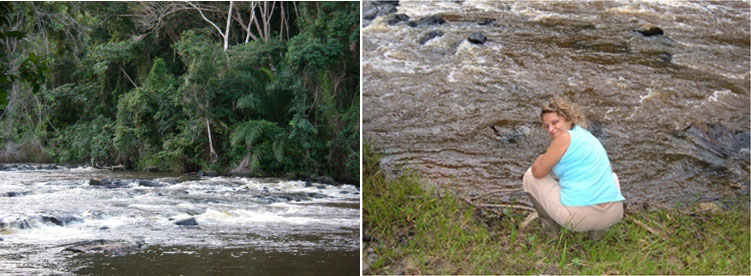
Our border is relatively short, no more than a couple of miles. When it leaves our lands, it passes by São Bernardo and goes to feed 12 miles of swamps before becoming a one-mile wide estuary to the ocean.
It is a major river, one that feeds water to maybe 300,000 people in the upper towns and sustains several colonies of fishermen on its immense estuary (more than a mile wide).

We had plans to use its water to irrigate the limes plantation during dry months: its supply of water is always abundant, even in the most stringent months of 2012. Maybe in the future…
We have a workers house down there, and we always thought of transforming it into an ‘advanced’ post for meditation… but that will have to wait as well…
And the river gives more: past the swamps, when near the town of Jaguaripe where it expands to well over a mile wide, anglers practice fishing of Robalo! People who know, know what this means!!
TheriachoSucupira (orMãe Bernarda)

The riacho Sucupira (a perennial stream of minor size) starts in two springs in the Peralba Sucupira limes plantation, right at the limit of the new crop. The water is so pure that it tested as mineral water. These two wells, and other on the other side of the hill, have been used for centuries by locals to get drinking water. They will be well preserved uas long as we shall be around!
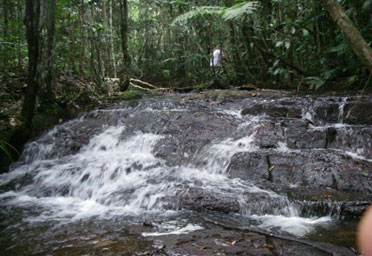
Its path meanders in the very thick of the Peralba Atlanticas, in fact it sort of divide the two areas. It is a succession of pools, waterfalls, and calm ponds, under the thickest canopy you can get from of our Mata Atlantica. It eventually ends in the Tirirí, in a magnificent pool just after the three major waterfalls. Lovely. Our jewel!
With some eight km of extension, by following it one can admire the forest at its best. For nearly 10 years now (since 2005) nobody has cut a single tree and the forest is closing all gaps that wood hustlers did open while robbing the place of the best wood. But they went no further. It takes 20 to 30 years for such places to recuperate fully to its primal state. For 10 years the forest has been recuperating. We need 10 or 20 more years.
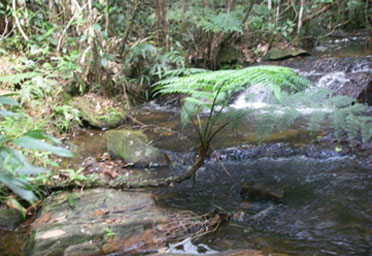
The upper branch passes by the Mãe Bernarda ruins of her ‘quilombola’, her former house. In the local lore, even before the freedom of the slaves in 1888, this woman, a shaman, was performing births and cures to the local galera where slaves were raised to be sold. She is venerated today by several elders who still speak of her as a powerful lady of immense courage and skills, who, for 50 or more years, till the 1930s, brought relief and refuge to humans whose only fault was a dark skin! A light of piety in an otherwise cruel world. But this is past. Today all this lore is just a memory that instills courage and self-respect to those descendants from slaves that still fight for a living in this area.
Then the riachoSucupirapasses through the Paradise Valley. Enclosed in a deep gorge, with a thin waterfall at its north entry,the riacho opens up to a small area populated by numerous animals: monkeys, parrots, even some jaguars. And naturally scorpions and snakes and devouring ants… but we shall leave that to the more courageous of visitors.
The riachoJacarandáand the Cachoeira do Urubu

A second jewel hidden in the forest and still little known to the world is the Cachoeira do Urubu, the Urubu waterfall. The name derives from a big bird, the Urubu da cabeçapreta (Coragypsatratus),a kind of vulture endemic to this place, that flies very high in the sky and controls the approaches to its domain from afar.
This riacho is born within the farm,and some four km upstream the main shoot crosses the high reaches of the Peralba Jacaranda area through one of the most dense and intense patches of our forest, before falling 60 meters down.
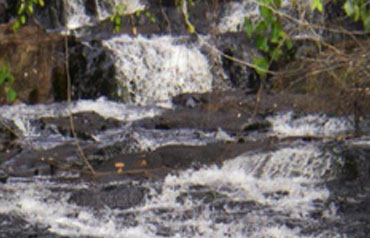
So thick and closed is the forest up there, one can walk through only by wading in the stream: to walk under the canopy would demand two ‘batidores’ who would open a path with their machete to get through. So thick is the vegetation, that some people become claustrophobic! The density of trees and of the thick under-growth creates a sensation of being enclosed in some strange animal or exotic land with myriads of unknown dangers!
Atlantic forest at its tremendous experience for those who appreciate such environments. The riacho falls down some 60 meters (140 feet) into a lovely pool almost at the level of the sea.
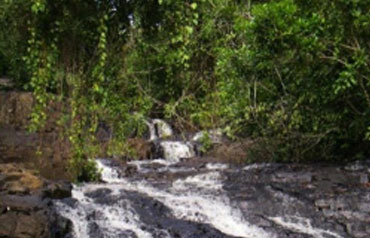
We left the access to it all very difficult, hard and uncomfortable to find. In 2005 when we arrived, people had cut a trail and picnicked there, leaving trash and cutting trees on the way. In 10 years, the path is almost invisible and the two km access from the road near the Tirirí to the waterfall is hard to find. With the demise of the small bridge, the access is now almost impossible to weekend visitors: only the most loyal forest lovers do the trek today. And it will stay like this until we shall open it and allow disciplined access to this beauty.
We brought this place back to it pristine and immaculate state by simply leaving it alone. We shall be back in due time and with due care.
The RiachoPeralbathe Lagoon of the Jacaré (the Alligator lagoon)

TheriachoPeralbais our river… or better, our riacho.
It is born from two wells 8 km into the farm, right where the plantation of limes is, in the Nova Rio area. And it goes through all ofPeralba Italia and then passes by the Yellow House.
Just after the springs (more wells, as the rogation of water is around 1m3 per minute), the riacho forms a sizable lagoon of some 500m X 120, the Nova Rio lagoon. We have thought of using this water for irrigation, but balked at the laws that govern such projects. Maybe in the future we shall return to this and carefully use such abundance.

Then theriacho coats the whole of the Italia plantation and forms another lagoon, the Italia lagoon, before descending nearly 200m through small waterfalls and numerous pools that we use to batheand swim in. A small wall near the Yellow House provided us with fish and prawns for many years. Today the frantic pace of the lime business has left such endeavors on the side. Who knows one day we go back to them…
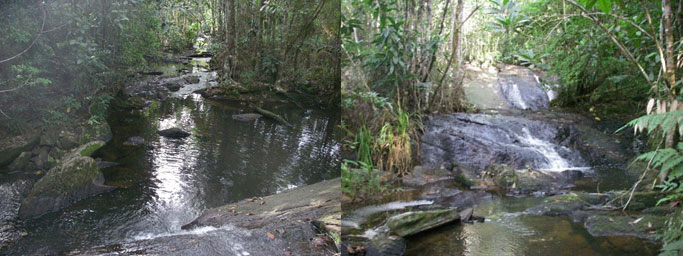
Then the riacho feeds a marvel: the Jacaré lagoon. With the size of 500m X 200m and encrusted inside heavy trees, the lagoon was home to a couple of alligators that terrified the neighbors until a bad guy killed the female, who knows why, as the penalty if caught would have been severe indeed. But such are the things of life. The male alligator eventually left the water to seeka new companion, only to be run over by a truck. Sad. We have asked a nearby grower of such animals to replenish our stock and revivethe place, but bureaucratic issues impeded that to date. It will be done soon. Promise.
The riachoOceano
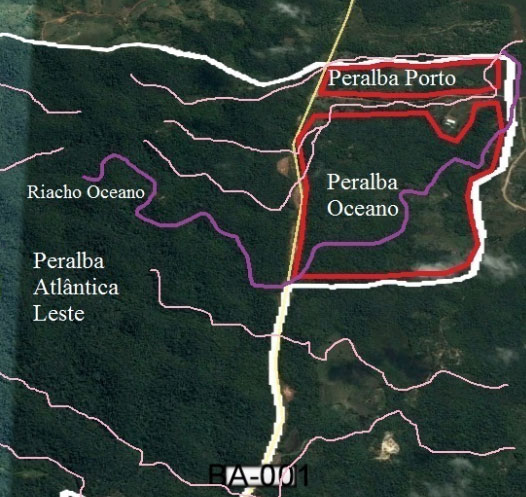
This riacho is almost unexplored as the access is impervious, set in a deep gorge, and seldom we go that way.
I think we went there maybe three times in all these years. In the last visit, we took this photo.
It’simportance for us is that it cuts across the plane and waters in the Peralba port before losing itself in the mangroves.

It almost certainly provides water to the Coronel Vianna house, which is still standing. When the eco-tourism project will be initiated, we shall start from here first by recuperating the house and the port.

.jpg)
.jpg)
.jpg)
.jpg)
.jpg)
.jpg)
.jpg)
.jpg)
.jpg)
.jpg)
.jpg)
.jpg)
.jpg)
.jpg)
.jpg)
.jpg)
.jpg)
.jpg)
.jpg)
.jpg)